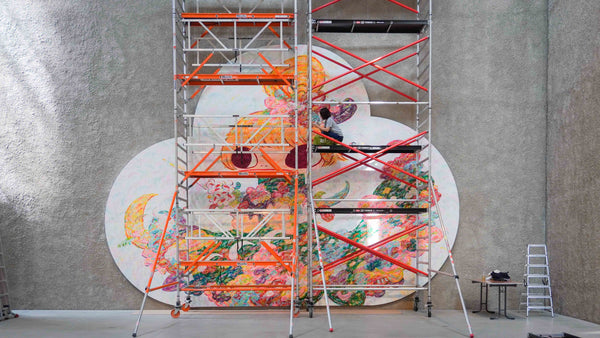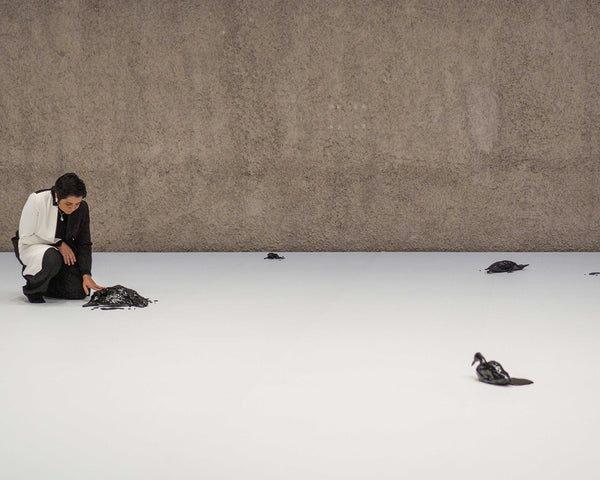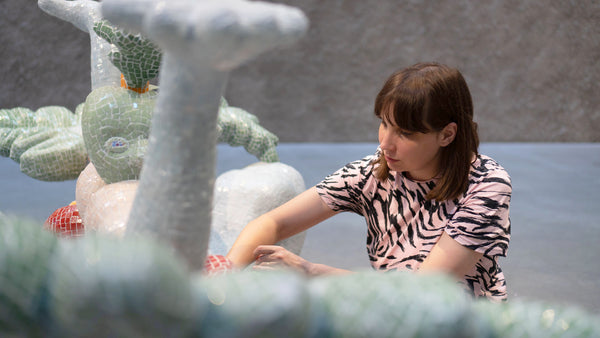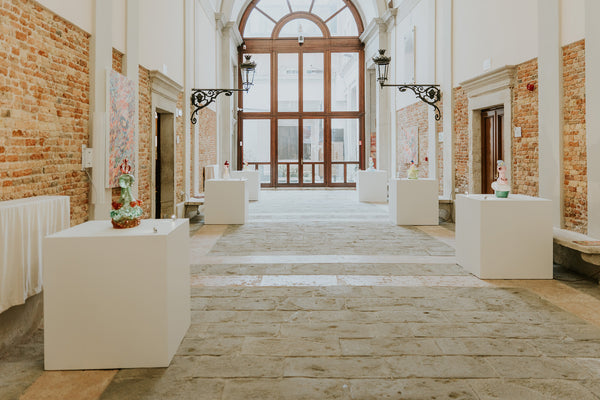AYAKO
ROKKAKU
“When
I
decided
to
make
sculptures,
I
wanted
to
do
it
in
a
traditional
way.”
11 April 2024
"For me, creating art has the underlying goal of bridging the gap
between different worlds, or at least buffering the pain that such gaps can inflict." – Ayako Rokkaku
"For me, creating art has the underlying
goal of bridging the gap between different
worlds, or at least buffering the pain that such gaps can inflict."
– Ayako Rokkaku
For the newest special issue of KÖNIG MAGAZINE, artist AYAKO ROKKAKU sat down for an interview about her transition from painting to sculpture and adapting her distinctive visual language to the sculptural realm, having a close relationship with different materials, and about her experiences with creating bronze as well as glass sculptures.
KÖNIG MAGAZINE: Ayako, you are known primarily as a painter. You work directly with the material, using your fingers and whole hands to apply color to your canvases. How did the idea come about for you to make sculptures?
AYAKO ROKKAKU: A few years ago, I collaborated with a young, traditional Japanese woodworker. He made wooden vases of various shapes using a traditional technique, and then I painted on them. At that time, I discovered the fun of being able to express things in 360 degrees and thought that, for the next time, I would like to create three-dimensional objects myself instead of just painting on them. Around that time, I started to develop a plan for a big solo exhibition in Shanghai, and I wanted to present some new work other than just paintings. As I had the opportunity to be introduced to a wonderful bronze foundry in Japan, I decided to try making bronzes.

Image by KÖNIG GALERIE © courtesy of the artist and KÖNIG GALERIE
KM: You worked with clay molds before casting in bronze. Was working with clay a natural extension of your painting technique, or did it involve a much greater leap from one medium to the other?
AR: Directly touching material is an important inspiration for me in painting, and the same goes for clay. So, I explored what kind of existence emerges from touching the clay. In the case of paintings, it is possible to intentionally make the outline of a figure vague or to express movement by abstract shapes or color combinations in the background. But this is not possible with clay, so at first, I found it very difficult to figure out how to construct the same atmosphere. I also tried out many ways to carve the eyes and create a subtle three-dimensional effect on the face.
KM: The patina of your finished bronze works is almost monochromatic, something very different compared to your other works.
AR: When I decided to make sculptures, I wanted to do it in a traditional way. The lack of color, facing grey clay and brown bronze, bored me a bit in the beginning, but then it made me focus more on form.

© Image by KÖNIG GALERIE
KM: Three new bronzes, that you produced at Noack Berlin, are now on view in Berlin. At the same time, your new glass sculptures are being exhibited in Venice. Do you see the two bodies of work as connected?AR: Actually, one of the bronzes is based on the same sketch as one of the glass sculptures, but the glass has a smooth, shiny colorful surface, and the bronze has a more organic shape made by my hands, so I think the impression is very different, which I think is interesting.

Images by KÖNIG GALERIE ©courtesy of the artist and KÖNIG GALERIE
KM: For the production of the glass sculptures, you went to Murano and worked at Berengo Studio.
AR: Murano is a small island with many glassware shops, and because I especially love small, cute, handmade items, the surroundings gave me such a fun feeling during my stay. Berengo is unique: while continuing the traditional method of glass work by hand, they are also specialized in using glass to realize the intentions of various contemporary artists. I was fascinated by the way this rather simple material, at first glance, was actually brought to life through the work of these glass masters.
KM: How did your working process develop?
AR: To make a bronze, I routinely touch the clay and observe how the shape grows. Also, when I paint, I never make a completed drawing beforehand. I touch the acrylic paint first and just start to paint, and the direction comes into focus through the process of painting. For me, I draw a lot of inspiration from actually touching my materials.
Since I can't shape glass through touch, I drew sketches while thinking of heated glass expanding, stretching, and changing shape, trying to imagine points of convergence between vivid colors and the smooth texture of the glass. Then, something like an imaginary ice cream appeared in my mind. People sometimes feel drawn to ice cream while taking a walk or traveling, having it provides some respite and comfort, stimulated by its coldness and taste. I thought it would be possible to make something like ice cream, only from glass.

Sketches of a glass sculpture by AYAKO ROKKAKU © courtesy of the artist
KM: When glass gets very hot, it does have a kind of creamy consistency, and the way the glass masters hand-formed the sculptures after your drawings could be seen as somehow similar to your live painting performances. They had to be quick and yet very precise to form what you drew, what you had in mind, while you watched and instructed.
AR: One of the reasons I do live painting performances is because I find the process of a painting emerges within the canvas, the way the colors and shapes change, and the organic progression of that process is beautiful and exciting. I want to share that moment with the people watching. I felt the same way when I saw the heated glass changing shape in the hands of the glass masters. I don't usually create works by leaving anything to others, but the way they handled it suited my ideas and made for a freer feeling in the sculpture. They reviewed my sketches several times in the process and carefully manipulated the condition of the glass using their technical expertise to realize my shapes. Just as there are finger marks on my paintings and bronzes, I managed to retain the impressions of my fingers on the glass sculptures through the use of a stick. The sensation of pressing the stick against the glass was new and inspiring to me.

© Images by KÖNIG GALERIE
KM: And the choice of colors?
AR: There are fewer choices for glass than with acrylic paints, and the individual colors cannot be mixed freely. Within a limited palette, we looked for ways to create effects that would match my style, such as combining elements that were variously transparent and opaque, or creating three-dimensionally in a mass of milky glass with the use of two or three colors.
KM: You produced eleven unique sculptures which are now presented in Palazzo Corner Mocenigo, together with six new paintings, two of which are triptychs. Why this special format?
AR: The new paintings were made after my experiences with glass and are based on the motifs of the glass sculptures. Usually, my works feature one (or one twin) main character on a single canvas. In making a triptych, each canvas can contain one main character, but the abstract world of the background remains connected. It can express both disconnection and connection. Also, by making spaces between canvases, it gives the feeling of seeing the other side of the world, like through a gap in a tree or a window frame, rather than facing each other directly. It has the effect of something like discovering a fairy from a short distance away. The title of the exhibition, “Detour for an Ice Cream Fairy”, emerged from all these processes.

Ayako Rokkaku, UNTITLED,2023, hand-blown glass, various dimensions, unique
Image based on photos by Francesco Allegretto © Courtesy of Berengo Studio and the artist
KM: You were born and raised in Japan. Now you are living between Berlin, Porto, and Tokyo. The title of this year's Venice Biennale is Foreigners Everywhere. How do you understand this theme?
AR: I empathize deeply with both meanings – of living as a foreigner and the alienation that makes one a foreigner to themselves. For me, creating art has the underlying goal of bridging the gap between different worlds, or at least buffering the pain that such gaps can inflict.





